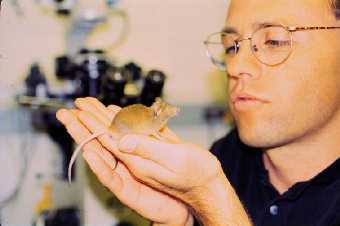Berkeley Scientists Develop Mouse Model For Sickle Cell Research |
 |
|
By Lynn Yarris, lcyarris@lbl.gov October 30, 1997 |
BERKELEY, CA -- Genetically engineered mice that fully mimic all the symptoms of human sickle cell disease have been developed by scientists at the Lawrence Berkeley National Laboratory. With this new mouse model, medical researchers finally have a means of effectively testing experimental treatments for the disease.Research by Drs. Chris Paszty and Edward Rubin of Berkeley Lab's Life Sciences Division has reported the creation of a new strain of mice that carries human hemoglobin genes with no counteracting mouse genes. This enables the mice to develop all clinical manifestations of the sickle cell disease.
The research has been reported in this week's issue (October 31) of the magazine Science. In addition to Paszty and Rubin, other authors of the Science paper were Catherine Brion, Mary Stevens, and Mohandas Narla of Berkeley Lab, plus Ewa Witkowska of the Children's Hospital Oakland Research Institute and Elizabeth Manci of the University of South Alabama Doctors Hospital.

Paszty with mouse engineered to model sickle cell disease
Each year approximately 100,000 babies in the world, mostly of African descent, are born with sickle cell disease, a painful and debilitating condition caused by a mutant hemoglobin gene. Although sickle cell disease has been extensively studied, there is still no effective treatment -- a failure attributed in part to the lack of an animal model that accurately reproduces the disease's symptoms.
"This work marks the end of a long road to genetically engineer mice that faithfully model human sickle cell disease," says Rubin.
Transgenic mice containing the human sickle genes have been engineered before, but these mice developed only mild symptoms of the disease. The problem was that in addition to carrying the mutant human genes responsible for sickle cell disease, these strains also carried normal mouse genes which counteracted the defective human genes.
"Through a series of complex transgenic and gene knock-out manipulations we were able to add the appropriate human genes as well as delete the (corresponding) mouse genes," says Paszty. "The end products are mice with irreversibly sickled red blood cells, anemia, and multi-organ pathology.
In contrast to the limited studies that can be performed in humans, Paszty and Rubin say these animals provide an opportunity for rapidly performing a wide range of experiments, and should play an important role in furthering our understanding of sickle cell disease and in developing improved therapies for treating sickle cell patients."
Sickle cell disease was once referred to as sickle cell anemia but the term"anemia" was dropped because it emphasized only one manifestation of the condition. Victims inherit from both their parents a gene that makes a mutant form of hemoglobin, the iron-containing protein in red blood cells which carries oxygen from the lungs to the rest of the body.
This mutant form of hemoglobin is called "hemoglobin S." Under certain physiological stresses, such as a decrease in oxygen, the hemoglobin S protein will polymerize, forming a rigid chain that may distort a blood cell into the shape of a "sickle." Lacking the flexibility of normal disc-shaped cells, these sickled cells are unable to squeeze through capillaries. This impairs the flow of blood, reducing the body's supply of oxygen. Damage from the reduction in oxygen accumulates, causing cell death in various tissues, most notably in the kidneys, liver, lungs, and spleen. This ultimately results in organ dysfunction and death of the individual.
All hemoglobin is made up of two polypeptide chains -- an alpha globin and a beta globin chain. Sickling occurs when a hemoglobin protein with a normal alpha globin chain and a mutant beta S globin chain precipitates out of solution during a state of deoxygenation.
Creation of the new sickle cell mouse model began about five years ago when Berkeley Lab researchers set out to engineer two new strains of knock-out mice, one which would no longer produce mouse alpha globin and one which would no longer produce mouse beta globin. At about the same time they succeeded in creating knock-out mice which did not produce any mouse alpha globin chains, a research group led by Dr.Tim Townes of the University of Alabama at Birmingham succeeded in creating knock-out mice which did not produce any mouse beta globin chains.
"Rather than duplicating each others' work we exchanged knock-out mice and then went our separate ways in terms of creating the human sickle hemoglobin transgenics," says Paszty. "It worked out well for both of our groups because after the long process of breeding these three strains of mice together we both managed to create mice with sickle cell disease."
Townes and his collaborators also have a paper describing their sickle cell disease mice in the October 31 issue of Science magazine.
With experts predicting a worldwide surge in the incidence of sickle cell disease, the perfection of this mouse model is extremely timely. Mice are highly valued for medical research because their physiology is quite similar to that of humans, they are fast-breeding, and their small size makes them easy to maintain and handle in large numbers.
Development of the sickle cell mouse was funded by grants from the National Heart, Lung, and Blood Institute, and the National Institute for Diabetes, Digestive, and Kidney Diseases, and in part, by the Office of Biological and Environmental Research in the U.S. Department of Energy.
The Berkeley Lab is a U.S. Department of Energy national laboratory located in Berkeley, California. It conducts unclassified scientific research and is managed by the University of California.
